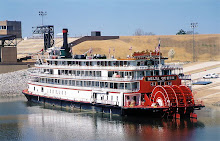
image from Bower's Fredericktown 1790-1990
Coal came out of this slope portal and went directly to the river tipple as seen in this 1929 photo. Shown are 8-ton gathering locomotives, these gathered the coal cars from various working places in the mine and made up the long trains for the haulage locomotives to pull out of the mine.

The Clyde mines have had several owners over many years. The original ( 1900 ) Clyde Coal Company of Pittsburgh sold their Fredericktown mine to W. J. Rainey of Cleveland, Ohio in 1925. From that point it was a captive mine to Republic Steel. In Pitt Gas, the William Pitt mine had been operating since at least 1916. Owned by the Pitt Gas Coal Company, it was worked by the Trumbull Coal Co. from around 1920. The Rainey company bought it in 1929. They called it Clyde # 2 and enlarged the town of Pitt Gas with the construction of 84 brick and tile houses. The Clarksville Gas Coal Co. operated a mine at Clarksville starting around 1920. At some point in 1925 or later, Rainey bought it and this is what must have become Clyde # 3.
W.J. Rainey, active in the business since the 1880's, owned many large mines. By 1904 he owned 3,200 coke ovens employing 18,00 men. Some of these, with partner T. J. Wood, were operated as the Rainey - Wood Coke Company. Known as the Cleveland Coke King, he was Frick’s main competitor in the Connellsville district. His thousands of acres of coal rights were scattered over the tri-state area . When he died in 1919 he left a fortune worth about 40 million dollars ( equal to half a billion and more in todays dollars ). The company operated under that name for years afterward.
.
 This porcelain sign likely dates from the Rainey takeover. It's very plain but is one of my most favorite pieces in my modest collection. This is because my father and his father worked together as buddys at # 3 in Clarksville.
This porcelain sign likely dates from the Rainey takeover. It's very plain but is one of my most favorite pieces in my modest collection. This is because my father and his father worked together as buddys at # 3 in Clarksville.So under The Rainey's control, Clyde #1 was at Fredericktown, Clyde #2 was at Pitt Gas, Clyde #3 was at Clarksville. Emerald ( originally Edward Mine, 1921) at Chartiers was called by some Clyde #4 but was since the middle 1920's ( if not always ) owned by the Emerald Coal and Coke Co. ( Hillman ). It seems that Clyde #2 was connected underground with Emerald at least for a time. In 1944 when there was a fire at Emerald ( which took six lives ) causing that mine to be sealed , much of Clyde had to be closed temporarily. In this same year there were about 1260 men employed at the three Clyde mines.
Rainey later ( around 1948 ) sold all these to Hillman Coal and Coke Company. Later they were operated under the name of Republic Steel.
Through this period of time, most commercial coal mines in our area were owned by the same few big dogs, Carnegie, Hillman, Rainey , H.C. Frick, the Jones brothers and a very few others. The Mellons were involved in the Pittsburgh Coal Company and had been working with H.C.Frick since the late 1870's. The names , on paper, moved back and forth over the years. The coal at a certain place was Rainey's , but Emerald mined it, at some point Hillman bought the coal from Rainey, or from Emerald , or whoever, and then Hillman mined it.

Blasting Cap Token From Clyde # 2 in Pitt Gas, my collection

1925 Map from Monongahela Railway 1903-1993, Gratz and Arbogast
Aerial view of Pitt Gas and Clyde # 2. The coal wagons came out of the slope three at a time and crossed the creek on a bridge to where the railcars were loaded. It looks as though the loading of cars here had stopped by the time of this 1939 photo. Gone too, are the railroad yard tracks. The tall concrete pier from the tipple still remains today beside the modern road.

This is Clyde #3 at Clarksville, looking south. The cars are marked for the Rainey-Wood Coke Company in this 1937 photo from the Mononghela Railway.


Aerial view of Clyde # 3 in 1939, tipple and cars underneath, the swinging bridge and the mine shop buildings. The slate dumps are behind the row of miners houses we called Shantytown. A mine track comes out of the tipple and curves around as it crosses over the Besco road and runs to the slate dumps south of the mine. Aerial images courtesy of Penn Pilot.

Clyde # 3 looking west, likely in the 1930's, photo courtesy Of Hoyle Family

2009 image by author
The Clyde # 3 site today, looking west. The swinging bridge is behind the photographer. The above tipple was in the center of this photo. The stables were to the left, near the underpass, against the track embankment. The piece of paved road in the foreground is part of the original road. To the left on this side of the old road were several frame houses that the company built for bachelor miners.
A very partial list of miners who worked in Clyde can be found here.



























No comments:
Post a Comment